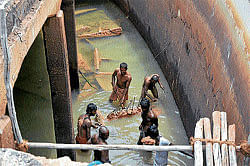
Providing clean and safe drinking water to consumers is a biggest challenge for civic bodies like Mysore City Corporation (MCC). In the light of the 74th Amendment to the Constitution, the roles and responsibilities of Urban Local Bodies like Mysore City Corporation (MCC) have increased significantly to provide basic facilities such as water supply and sanitation to the community, on priority. The said amendment has enabled the Urban Local Bodies to become financially and technically sound to provide these basic civic amenities to the community.
Though the rules and regulations of the constitution clearly specify the urban local bodies to provide clean and safe water to people, this right of the residents was somehow not realised.
The lack of safety measures and poor maintenance of ground level reservoirs which store the water as main sources, and from where it will supplied to other parts of the Mysore city after treatment, is posing a grave threat for the health of the people.
With clay, silt, calcium and magnesium salts getting collected in layers at the bottom of ground level reservoirs without any check from the authorities concerned, has added to the problem.
Residents had filed loads of complaints about the supply of water which didn’t seem fit for consumption, several times. There are complaints from public about the roof of several ground-level reservoirs having collapsed or damaged since they were constructed several years ago. With none clearing the residues of the roof that had caved in, the citizens were exposed to various kinds of diseases.
According to sources, there are eight ground level reservoirs managed by Mysore City Corporation with the assistance of Karnataka Water Supply and Sewerage Board (KUWSSB) and JUSCO, a private agency at present.
The High level Reservoir (HLR) constructed at Yadavagiri in 1968 caters to major areas of Krishnaraja, Narasimharaja, parts of Chamaraja Assembly segments. There are three storage tanks constructed in HLR here, with the storage capacity of 5 million gallons of water.
The Central Reservoir(CSR) at Vijayanagar was built in 1974 to supply drinking water to majority of Chamaraja Assembly segment. The storage capacity of this reservoir system is 12 million gallons. Other two reservoirs constructed at Kuvempunagar in 1995 have storage capacity of 2.5 million gallons. The other underground reservoirs constructed near German Press in the year 2002 with the storage capacity of 2.5 million gallons cater to the needs of parts of Narasimharaja Assembly segment. The Devanur ground level reservoir with a storage capacity of 2.5 mg to supply water to its surrounding areas.
As of today, there are 34 overhead tanks constructed in various parts of the city barring the new tanks constructed under JnNURM project. The total storage capacity of water in all these tanks is 2.5 million gallons. The total area of the water distribution system stretch around to 141 kilometres area in Mysore city.
As per the official statistics, the city was receiving 41.5 mgd against targeted 53.5 mgd water per day. This is owing to the distribution and transmission loss caused by leakage and wastage of water due to poor water pipeline and inefficient outdated machines.
Besides, water pilferage by farmers enroute to pipeline network from river sources to underground level reservoir sources has added to the water shortage problem. The major water sources of the city are Belagola Ist stage which was set up in the year 1896 with a capacity of 3.5 mgd. Belagola second stage in 1898 with a capacity of 8 mgd of water supply, however, the actual water reduced to five mgd. The Hongalli second stage in the year 1969 with a capacity of 8 mgd.
The actual capacity is 4.9 mgd. Hongalli third stage in 1979 with water pumping capacity of 12 mgd, but only 9.2 mgd was drawn. Another water source of the city is Melapura first and second stage which was constructed in 2002 with the capacity of 22 mgd but only 18 mgd of water is available from these water pumping stations. Besides, about one mgd of water is available through thousands of borewell, hand pumps and electrically monitored hand pumps.
Set up forum
Speaking to City Herald, Convener of Association of Concerned and Informed Citizens (ACICM)M Lakshmana said apart from providing minimum required quantity of drinking water to the people, the operation and maintenance authorities should always bear in mind that its quality is maintained at all times to safeguard the health of the community.
City level consumer forums may be set up to keep a vigil on the water sources to prevent possible contamination and make periodical reporting to the operation and maintenance agencies for appropriate action well in advance. At the same time, awareness programmes on water conservation, wastage prevention, water quality, personal hygiene etc. may have to be designed and implemented with the help of NGOs, Residential Welfare Associations and neighbourhood committees.
At the same time, all such complaints received by the operation and maintenance agencies should be attended to within a reasonable time frame, so as to win the confidence of the consumers but the water supply agencies never worried about this, he said.